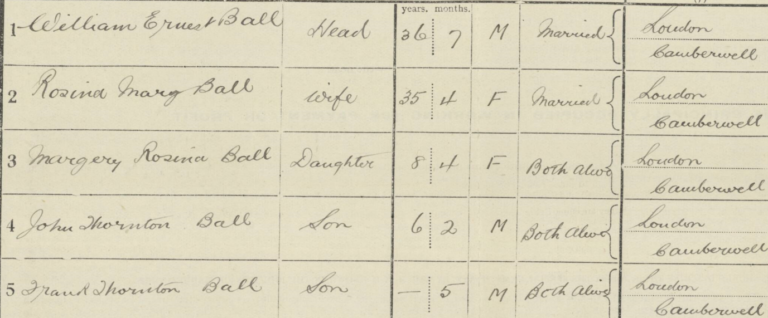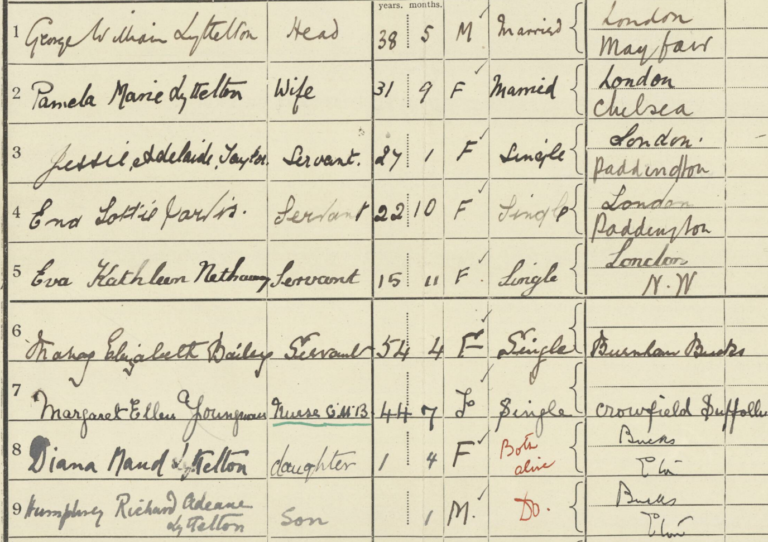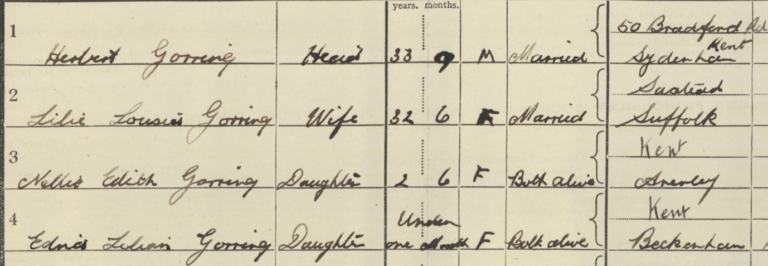I was pleased to get my first peek into the 1921 Census when it was made public earlier this year. Like others with an interest in historical and genealogical research, I was expecting to see the maiden appearances of relatives not born until after the previous census of 1911. And knowing that there won’t now be another public release of a census for 30 years, it was especially pleasing to find recently born relations who had only just made it onto the books in 1921.
I began to wonder about others in a similar situation and so I looked up a list of births from 1921. Of the hundreds of famous names mentioned it was the familiar faces from stage and screen who stood out and I decided to see if I could also find some of their ‘debut public appearances’ in the online 1921 Census. By the end of an hour or two’s research I had looked into the lives of just a handful of other families in 1921 but what struck me was the familiar mirror they all held up to a diverse British society so often characterised by class.
My first discovery was a then five-month-old Frank Thornton Ball. He is perhaps more often remembered today as pompous department store floor manager Captain Peacock from the 1970s television comedy series ‘Are You Being Served?’ With that character’s besuited, upright, managerial image in mind, I thought it fitting to discover that in 1921 Frank’s father’s occupation was bank clerk, and furthermore that his family lived in a typical bay-fronted Victorian end-of-terrace in now well-to-do Dulwich. It was a vignette of British middle-class life that could easily have belonged to the fictional Peacock family themselves.

On a different part of the socio-economic scale, and on the other side of the country, I next uncovered the baby son of a Welsh miner and English mother living in the two ground-floor rooms of a small terraced house in Caerphilly, South Wales. Named after his father, a then three-month-old Thomas F[rederick] would years later go on to entertain millions as zany, fez-wearing comedian and hapless magician Tommy Cooper. His surroundings in 1921 may have been humble (even ignoring the family of eight squeezed into the three rooms upstairs) but nonetheless Tommy Cooper evolved into a much-loved entertainer who, at the time of his death on stage at the age of 63, left behind a small fortune. He’d ventured far from his roots by then but coincidentally he was closer again at the end to the eventual custodian of that original census form that his father had filled in right at the start of his life in 1921: Tommy was cremated at Mortlake Crematorium which is barely a stone’s throw from the site of The National Archives in Kew.

Clicking back on London for my third discovery was a hop from comedy to drama. Although only 10 days younger than baby Tommy, and like him, then the only child of a young couple in their twenties, a little Derek Vanden Bogaerde had otherwise really rather different beginnings in life and in turn would go on to find fame in an altogether rather different style … as debonair screen idol and twice BAFTA award-winning actor, Dirk Bogarde.
Dirk’s father’s family were of Flemish origin and his mother was Scottish so, like young Tommy Cooper, Dirk was of mixed nationality. And in similar circumstances to the Coopers in 1921, the Bogaerdes also had to share their house with a second family. But there the similarities end: as art editor for The Times newspaper, Dirk’s father’s occupation was very much white collar. Their family home was a large semi-detached maisonette in the affluent suburb of Hampstead. And where in Caerphilly the Coopers’ house had just five rooms to divide among 11 individuals, at the Bogaerdes’ property the conditions were the opposite: six individuals with 11 rooms.

The 1921 Census was originally planned to have taken place on the night of Sunday 24 April but was postponed until 19 June because of widespread industrial unrest that year. An entirely trivial consequence of those historic circumstances are the last two 1921 births that I was additionally able to discover, both of them coming in the final week of May …
Scrolling further still along the socio-economic scale I next came upon Eton College in Buckinghamshire, one of the oldest and most prominent public schools in England. In 1921, George Lyttelton (second son of the 8th Viscount Cobham), was a teacher at Eton and enjoyed in-school accommodation along with his wife, two children, four servants and a nurse. The nurse had presumably just been employed because of the arrival less than a month earlier of a baby son, Humphrey Richard Adeane Lyttelton. To me, Humphrey Lyttelton, or ‘Humph’ as he would affectionately come to be known, was always a grand old, white-haired veteran of the entertainment world. It is odd therefore to think of him at a time when he was just a babe in arms. I knew of him less for his eventual accomplishments in the jazz world than for his enduring presence as compere of the BBC radio comedy series ‘I’m Sorry I Haven’t a Clue’. His hosting of that show was characteristically droll and mock-cynical and yet somehow always warm and affable. I was quite surprised to discover his rather grand, aristocratic beginnings.

The Lyttelton household of June 1921 was a large one at nine individuals – even if five of those were actually domestic employees. Back in London, in a property just south of Crystal Palace, I next found another nine individuals (in a similar division of four and five). None of these inhabitants were servants however – these were just two working families occupying a collective total of eight rooms. The smaller family with three of those rooms were the Gorrings: railway guard Herbert, his wife Lillie and their two young daughters, Nellie and Edna. Baby Edna wasn’t yet three weeks old when the census was taken on 19 June but I wouldn’t come across her until she was already well into her sixties. I was instantly captivated by her award-winning performance (in Mike Leigh’s film ‘High Hopes’) playing one of the last working-class incumbents of a rapidly-gentrifying period street in 1980s London. Very soon after that, actress Edna Doré went on to become a household name in the guise of indomitable ‘Mo Butcher’ in the BBC soap ‘EastEnders’.

Interesting parallels have been drawn between recent national events and events in Britain during the 1920s. Census data is one source for revealing noteworthy historical patterns like that but it can also highlight the enduring trends of a more personal nature. I had only intended to peek into the backgrounds of a few celebrities out of idle curiosity, but nonetheless I happened to find five representatives from all strata of British society. As these were individuals from stage and screen it might be tempting to call this life imitating art … but perhaps it is the other way around?!
Fascinating, many thanks for this ! Unfortunately, the 1921 Census of Scotland has yet to be published, I’m very much looking forward to researching my own family at that point in time.
I too am waiting for the 1921 Census for Scotland and of course Scotland has kept their Census for 1931 safe and it will be out in ten years’ time unlike that for ‘England and Wales’. I am glad you have found some names (unlike my maternal grandfather’s surname which has been transcribed with an ‘H’ missing, despite the fact he wrote it in capital letters) and that FMP think Winston Churchill was born in Blantyre (Scotland) and not Blenheim, Oxfordshire, as on the Census return!.
Totally fascinating
The 1921 census brings ‘history’ closer to home. My mother Edna is there in Staffordshire as a 4 month old baby, together with her parents and elder sister.
Why do the children’s entries say “Both Alive”? It is not a notation I’m familiar with (in the U.S.) Thanks.
the instructions on the form for that column say that for the listed children,15 and under, state whether parents are “Both Alive” , “Father Dead”, “Mother Dead”, or “Both Dead”, collected as a way for the govt. to judge the state of the family since WWI and the impact its horrendous death toll had on society.
The government were concerned about future planning and needed to understand the effects three years on from the end of World War I and in the wake of the Spanish flu pandemic. The only census to ask about all children under 15, if both parents were alive or if they had lost one, or both. So you will see “Both Alive”, “Mother Dead”, “Father Dead” or “Both Dead”
Thank you. I thought it might have something to do with mother and baby, but it seemed to be said of children too old for that.
This is a very interesting article. I am enthralled at the English census records for my English ancestors, it makes it so much easier to trace lineage. Unfortunately (for research purposes) I am in Northern Ireland where we only have the 1901 and 1911 complete census and only fragments of any prior census as most were destroyed in the 1916 rising in Dublin.
Due to partition there was no census taken in 1921. Partitioned Ireland had a census taken in 1926 although the census for the North of Ireland were destroyed…..accidently???
Who knows? So the next census for the North of Ireland was taken in 1937, only another 15 years to wait…..
Thank you for this blog. It was fascinating, but not really surprising, the majority of actors seem to come from the middle and upper classes but not so comedians.